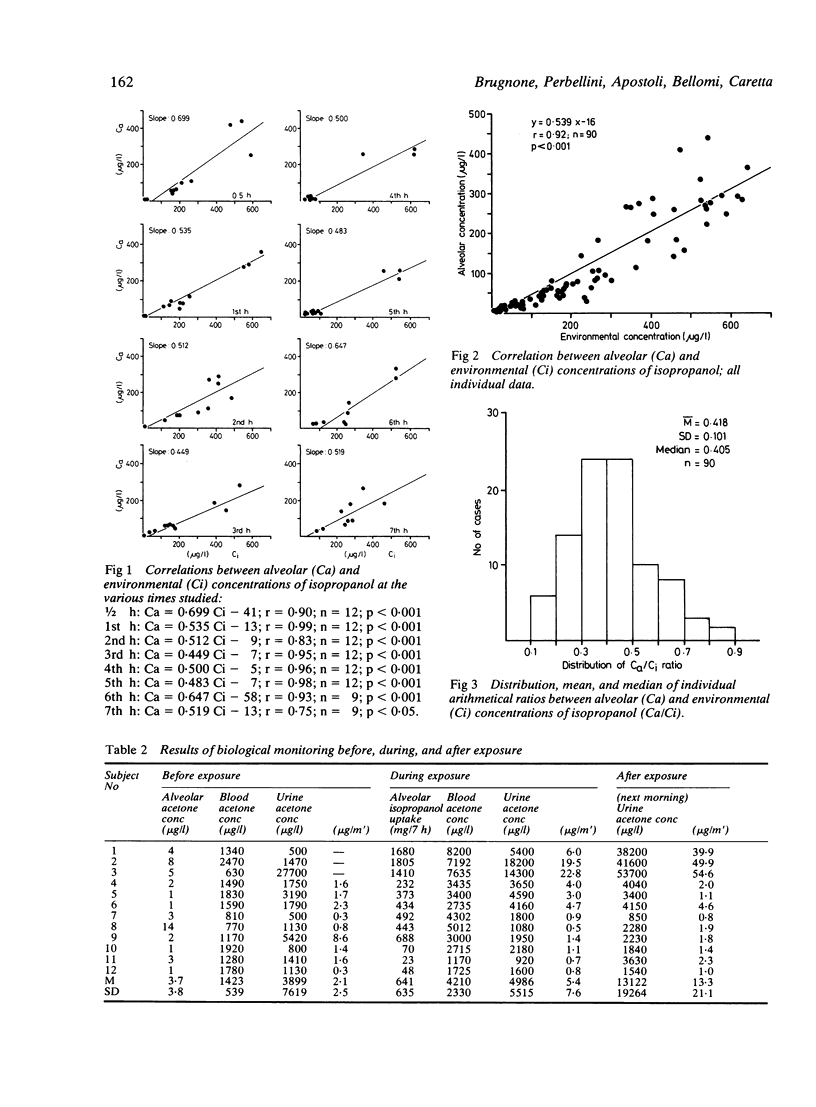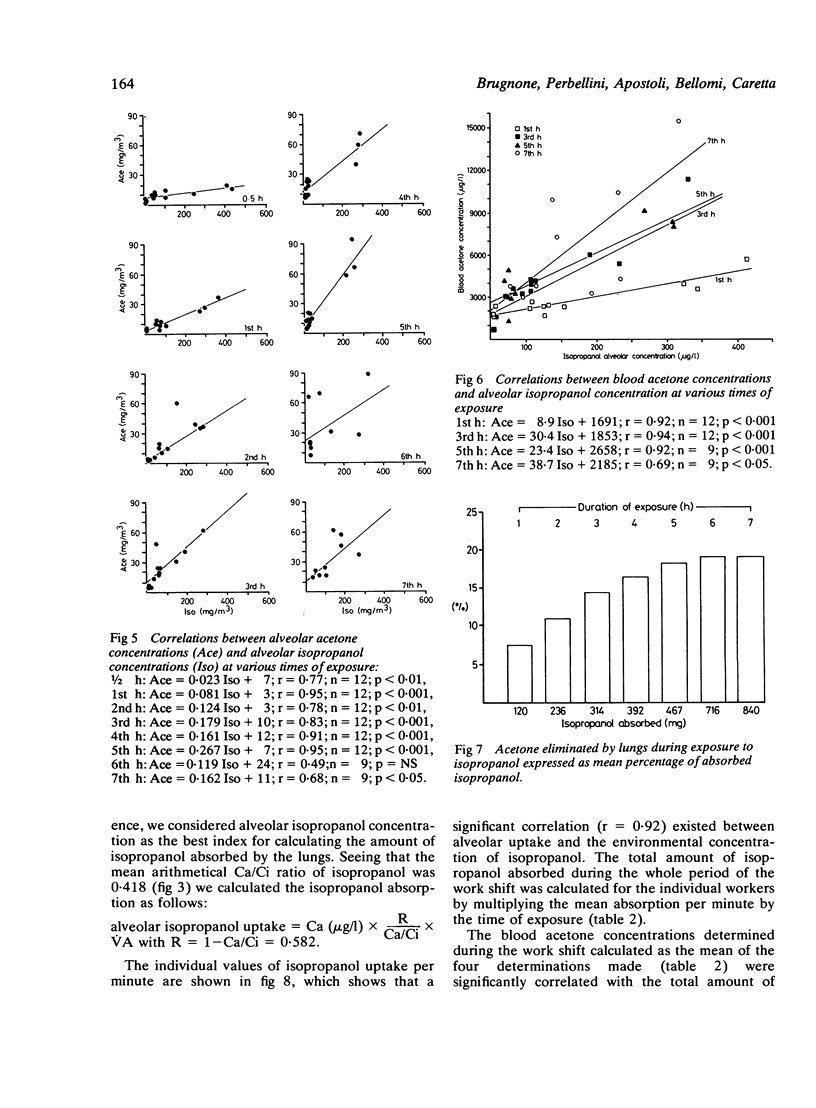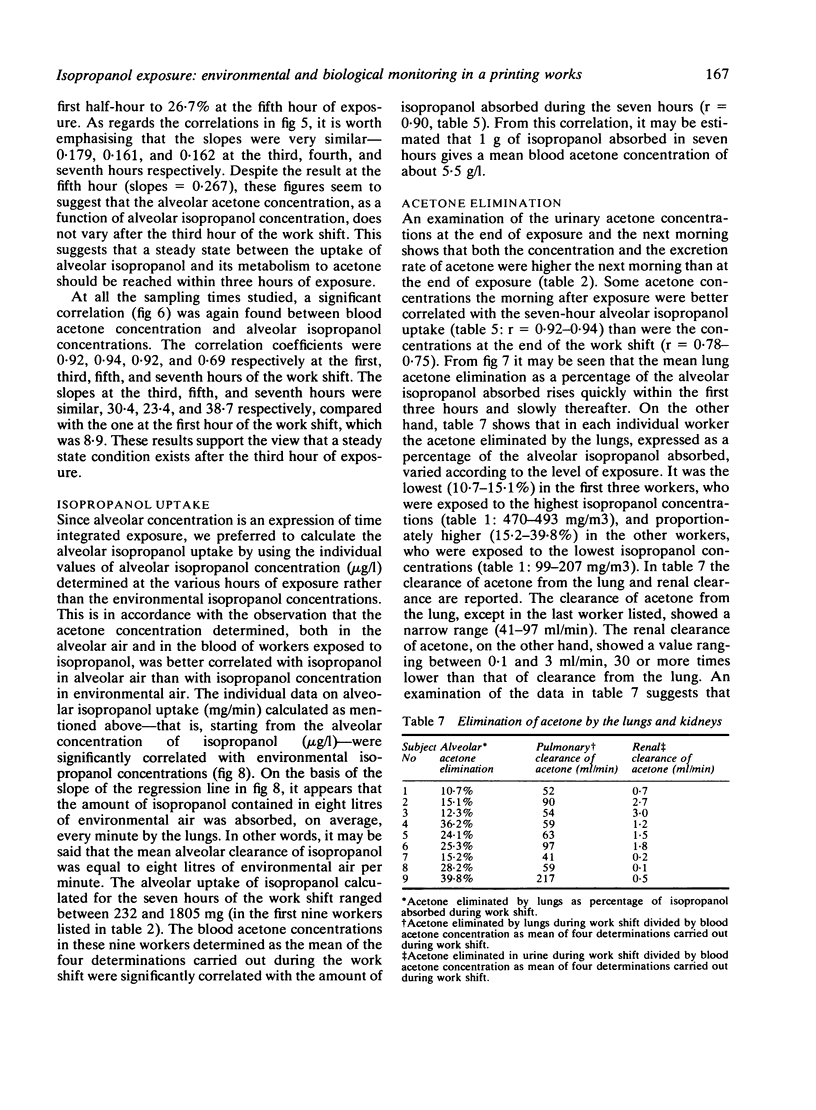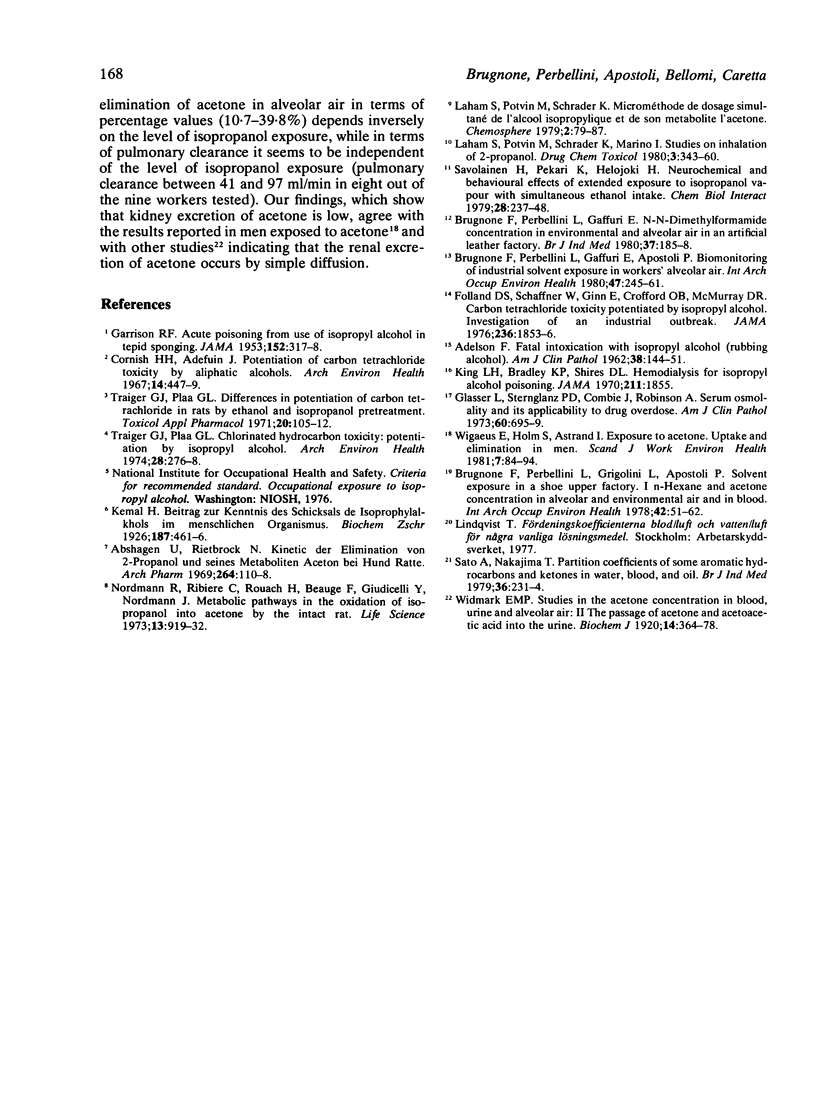Abstract
Occupational exposure to isopropanol was studied in 12 workers by testing environmental air, alveolar air, venous blood, and urine during their work shift. Isopropanol, which ranged in environmental air between 7 and 645 mg/m3, was detected in alveolar air, where it ranged between 4 and 437 mg/m3, but not in blood or in urine. Alveolar isopropanol concentration (Ca) was significantly correlated with environmental isopropanol concentration (Ci) at any time of exposure. The value of the arithmetical Ca/ci ratio was 0.418 (SD 0.101). Acetone, which is a metabolite of isopropanol, was found in alveolar air, blood, and urine in concentrations that were higher during exposure than before. Alveolar and blood acetone concentrations were highly correlated with alveolar isopropanol concentrations at any time during exposure. Acetone ranged between 0.76 and 15.6 mg/l in blood, between 4 and 93 micrograms/l in alveolar air, and between 0.85 and 53.7 mg/l in urine. Alveolar (Ca) and blood (Cb) acetone concentrations were highly correlated (r = 0.67), with a Cb/Ca ratio of 101. Alveolar isopropanol uptake ranged between 0.03 and 6.8 mg/min and was highly correlated with environmental isopropanol concentration (r = 0.92). During exposure, acetone eliminated by the lungs ranged between 20 and 273 mg in seven hours and in urine between 0.3 and 9.6 mg in seven hours. Acetonuria was higher the next morning than at the end of exposure.
Full text
PDF








Selected References
These references are in PubMed. This may not be the complete list of references from this article.
- ADELSON L. Fatal intoxication with isopropyl alcohol (rubbing alcohol). Am J Clin Pathol. 1962 Aug;38:144–151. doi: 10.1093/ajcp/38.2.144. [DOI] [PubMed] [Google Scholar]
- Abshagen U., Rietbrock N. Kinetik der Elimination von 2-Propanol und seines Metaboliten Aceton bei Hund und Ratte. Naunyn Schmiedebergs Arch Pharmakol. 1969;264(2):110–118. [PubMed] [Google Scholar]
- Brugnone F., Perbellini L., Gaffuri E., Apostoli P. Biomonitoring of industrial solvent exposures in workers' alveolar air. Int Arch Occup Environ Health. 1980;47(3):245–261. doi: 10.1007/BF00381682. [DOI] [PubMed] [Google Scholar]
- Brugnone F., Perbellini L., Gaffuri E. N-N-dimethylformamide concentration in environmental and alveolar air in an artificial leather factory. Br J Ind Med. 1980 May;37(2):185–188. doi: 10.1136/oem.37.2.185. [DOI] [PMC free article] [PubMed] [Google Scholar]
- Brugnone F., Perbellini L., Grigolini L., Apostoli P. Solvent exposure in a shoe upper factory. Int Arch Occup Environ Health. 1978 Sep 15;42(1):51–62. doi: 10.1007/BF00385711. [DOI] [PubMed] [Google Scholar]
- Cornish H. H., Adefuin J. Potentiation of carbon tetrachloride toxicity by aliphatic alcohols. Arch Environ Health. 1967 Mar;14(3):447–449. doi: 10.1080/00039896.1967.10664767. [DOI] [PubMed] [Google Scholar]
- Folland D. S., Schaffner W., Ginn H. E., Crofford O. B., McMurray D. R. Carbon tetrachloride toxicity potentiated by isopropyl alcohol. Investigation of an industrial outbreak. JAMA. 1976 Oct 18;236(16):1853–1856. [PubMed] [Google Scholar]
- GARRISON R. F. Acute poisoning from use of isopropyl alcohol in tepid sponging. J Am Med Assoc. 1953 May 23;152(4):317–318. doi: 10.1001/jama.1953.63690040001007. [DOI] [PubMed] [Google Scholar]
- Glasser L., Sternglanz P. D., Combie J., Robinson A. Serum osmolality and its applicability to drug overdose. Am J Clin Pathol. 1973 Nov;60(5):695–699. doi: 10.1093/ajcp/60.5.695. [DOI] [PubMed] [Google Scholar]
- King L. H., Jr, Bradley K. P., Shires D. L., Jr Hemodialysis for isopropyl alcohol poisoning. JAMA. 1970 Mar 16;211(11):1855–1855. [PubMed] [Google Scholar]
- Laham S., Potvin M., Schrader K., Marino I. Studies on inhalation toxicity of 2-propanol. Drug Chem Toxicol. 1980;3(4):343–360. doi: 10.3109/01480548009030125. [DOI] [PubMed] [Google Scholar]
- Nordmann R., Ribiere C., Rouach H., Beauge F., Giudicelli Y., Nordmann J. Metabolic pathways involved in the oxidation of isopropanol into acetone by the intact rat. Life Sci. 1973 Oct 1;13(7):919–932. doi: 10.1016/0024-3205(73)90082-9. [DOI] [PubMed] [Google Scholar]
- Sato A., Nakajima T. Partition coefficients of some aromatic hydrocarbons and ketones in water, blood and oil. Br J Ind Med. 1979 Aug;36(3):231–234. doi: 10.1136/oem.36.3.231. [DOI] [PMC free article] [PubMed] [Google Scholar]
- Savolainen H., Pekari K., Helojoki H. Neurochemical and behavioural effects of extended exposure to isopropanol vapour with simultaneous ethanol intake. Chem Biol Interact. 1979 Dec;28(2-3):237–248. doi: 10.1016/0009-2797(79)90164-9. [DOI] [PubMed] [Google Scholar]
- Traiger G. J., Plaa G. L. Chlorinated hydrocarbon toxicity. Potentiation by isopropyl alcohol and acetone. Arch Environ Health. 1974 May;28(5):276–278. doi: 10.1080/00039896.1974.10666486. [DOI] [PubMed] [Google Scholar]
- Traiger G. J., Plaa G. L. Differences in the potentiation of carbon tetrachloride in rats by ethanol and isopropanol pretreatment. Toxicol Appl Pharmacol. 1971 Sep;20(1):105–112. doi: 10.1016/0041-008x(71)90094-9. [DOI] [PubMed] [Google Scholar]
- Widmark E. M. Studies in the Acetone Concentration in Blood, Urine, and Alveolar Air. II: The Passage of Acetone and Aceto-Acetic Acid into the Urine. Biochem J. 1920 Jul;14(3-4):364–378. doi: 10.1042/bj0140364. [DOI] [PMC free article] [PubMed] [Google Scholar]
- Wigaeus E., Holm S., Astrand I. Exposure to acetone. Uptake and elimination in man. Scand J Work Environ Health. 1981 Jun;7(2):84–94. doi: 10.5271/sjweh.2561. [DOI] [PubMed] [Google Scholar]


